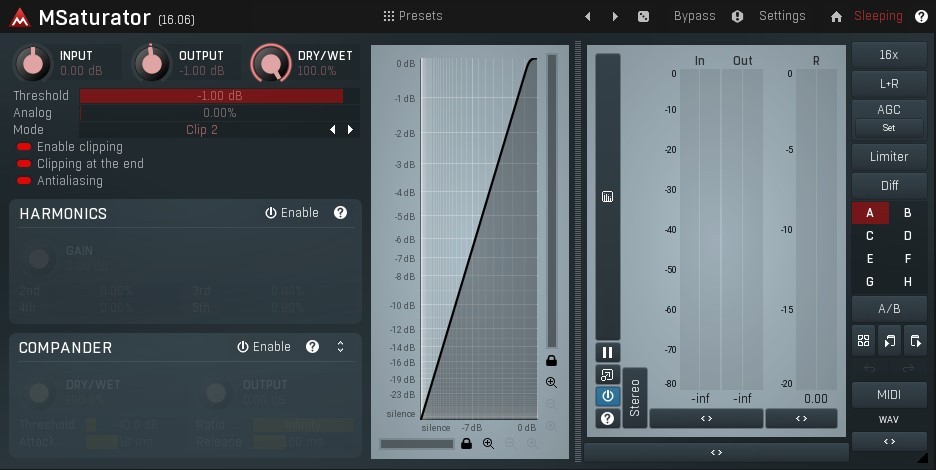Saturating the Master BUS
Jun 7, 2023, 4:32:00 PM
When it comes to saturation during mastering process, I tend to be really careful about what plugins I use, and how much of it is applied. It's been said thousand times, but it's really easy to overdo and ruin otherwise a good mix when things are overdone in mastering. Anyway, one thing that can ease up the workload on your final limiter is to bring a hard/soft clipper before it. Clipper will naturally shave off any peak inconsistencies, that would otherwise "confuse" the limiter, and it will basically apply a "natural" compression to the whole mixdown.
But how do you know, which saturation plugin is suitable for mastering? Other than the sound character itself, one thing I look at is how much aliasing it produces. During mastering it's absolutely necessary to use something, that can handle the whole spectrum range without introducing any major bumps (foldback distortion) below the root frequency, that are above the noise floor. You would be surprised, by how many plugins handle this issue really badly, even when they support oversampling.
I tend to stick to hardware saturation, but in my opinion these two plugins are very decent candidates for a day to day mastering operations. 🙂
Apogee Soft Limit (free)
Sound characteristics:
- Gently brings out mids.
- Controls the bass.
- Puts a gentle roll off on highs.
Tips:
- 1 or 2 dB shave off is generally enough on master before final limiter.
- Make sure to switch to 16x oversampling.
- Although the high spectrum roll off is barely noticeable, you might want to put a musical EQ (BootEQ MKIII) after it and shelf boost a bit from 8kHz.
- Set the output to -1dB.
- By double clicking the knobs, you can set exact values.
Aliasing test - 16x oversampling - Introduces 0.3ms latency (insanely low):
- 440Hz with 1dB clipping = No aliasing above -100dB floor.
- 5000Hz with 1dB clipping = No aliasing above -100dB floor.
- 20kHz with 1dB clipping = 5 bumps above -100dB, 2 of which are above -60dB floor. 1 bump is showing around 10 - 20 Hz above -100dB... very small but it's there.
Conclusion:
Soft Limit is a pretty clean and nice sounding soft clipper. Just make sure to put a 20 Hz low cut after it to eliminate the low end foldback bump. From what I have seen, even a gentle 6 dB/o roll off helps to mitigate this issue.
Melda Saturator (free)
Sound characteristics:
- Four soft clipping, three hard clipping, and two fold modes, that you can chose from.
- Hard clipping shaves off peaks without compromise and almost without any drastic change in sound. Most noticeable in better midrange.
- Soft clipping behaves like a gentle high roll off, genrally warmer mids and bass.
- Fold is straight up distortion.
- Hard clipping can be overdone faster than in other plugins, so pay extra attention.
Tips:
- Each mode is suitable for different situation, but generally, really loud material can handle the hard clipping mode in decent setting, without any noticeable change in sound other than the natural compression.
- On the other hand, soft is usually better for less busy mixdowns, where hard clips would be distracting.
- Clicking on knob values and double clicking on sliders brings up a window, where you can set exact values.
- Again, 1 or 2 dB shave off is generally enough on master before final limiter, but squish to your heart's content if you feel like it. 🙂
To emulate a final stage clipper, set the plugin like this:

- Output to -1dB (top left)
- Threshold slider to -1dB
- Analog to 0%. This is really important, otherwise, aliasing becomes a problem, presumably because the plugin introduces some whitenoise, which then folds back from Nyquist.
- Mode "Clip 2" which is the most aggressive one. Use this one and go from there.
- Enable Clipping, Clipping at the end, Antialiasing.
- Top right corner, click the 1x and change it to 16x for both rendering and normal.
Aliasing test - 16x oversampling - Introduces 16ms latency (very low):
- 440Hz with 1dB clipping = No aliasing above -100dB floor.
- 5000Hz with 1dB clipping = No aliasing above -100dB floor.
- 20kHz with 1dB clipping = 2 bumps above -100dB, but below -60dB floor.
Conclusion:
MSaturator is an ABSOLUTELY CLEAN BEAST. Packed with features, killer oversampling, clean sound... how is this plugin free?
